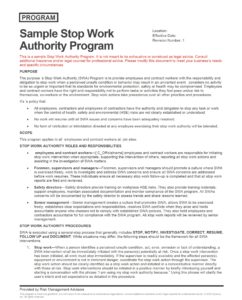In any organization, it’s everyone’s responsibility to help detect workplace hazards and prevent accidents. That’s why it’s crucial for your staff to be actively involved in workplace health and safety initiatives, such as a stop work authority (SWA) program. These programs encourage employees to keep an eye out for potential workplace safety hazards, thus helping identify risks before they result in costly and tragic incidents.
Review the following guidance for a further understanding of what SWA programs are, how they operate and the benefits of implementing this type of program within your workplace.
SWA Programs Defined
At a glance, SWA programs provide employees with both the responsibility and obligation to stop working if they recognize a perceived unsafe behavior or condition in the workplace. From there, employees must halt work processes until the problem has been corrected. Although these programs are not required by OSHA, they are strongly encouraged as a way to get employees more involved in workplace health and safety processes and strengthen an organization’s overall safety culture. However, keep in mind that it is still the employer’s—not the employees’—legal responsibility to ensure a hazard-free
work environment.
How SWA Programs Work
When developing an SWA program or policy, keep the following considerations in mind:
- Employees must be able to recognize unsafe work. Don’t assume that your staff knows the difference between safe and unsafe work. Be sure to educate them on potentially unsafe conditions and behaviors. Examples of unsafe work include:
- Violations of occupational health and safety standards or organizational safety policies
- Inadequate (or lack of) training
- Improper use of equipment, damaged equipment or a lack of necessary equipment
- Fire hazards
- Fall hazards
- Near-miss incidents
- Adverse or dangerous working conditions
- Employees must be comfortable stopping work. Even with an SWA program in place, your employees might not feel comfortable calling out unsafe work conditions or hazardous behaviors of their coworkers. Make sure your staff feels empowered through the SWA process by ensuring all supervisors actively support the program and providing incentives for program usage (e.g., sharing
employees’ SWA efforts as success stories). Further, be sure that your employees understand that there will be no punishment for reporting unsafe work concerns, and that anyone can question the safety of another person’s actions in the workplace—regardless of seniority or discipline. - The employer must clearly communicate SWA program expectations and outcomes. It’s crucial to clearly define your organization’s SWA program expectations and outcomes through an effective SWA policy. Be sure to communicate that participation in your SWA program is required, not voluntary. Employers should consider formalizing their SWA program through a written policy that employees are required to sign off on.
The SWA Program Process
SWA programs typically follow this six-step process:
- Stop the unsafe work. First, the employee(s) that recognizes unsafe conditions or behaviors must initiate a stop-work intervention with anyone who could potentially be at risk. This entails asking
affected employees to stop working and sharing the perceived safety hazard at hand. - Notify a supervisor. Next, the employee(s) needs to notify their supervisor of the stop-work intervention.
- Investigate the issue. Then, the SWA initiator, affected employees and supervisor should discuss the condition or behavior in question and come to an agreement on whether it is safe or unsafe. If
everyone agrees that the condition or behavior is safe, the affected employees and supervisor should thank the SWA initiator for their concern and return to work. If everyone agrees that the condition or behavior is unsafe, a stop-work issuance form needs to be completed and work must be suspended until the problem is fixed. - Fix the problem. In the event that the condition or behavior is deemed unsafe, the problem must be fixed according to the modifications or corrections suggested in the stop-work issuance form. It’s
important to consult qualified experts during this process to ensure that all safety concerns have been properly remedied. - Resume work. Once the problem has been fixed, all affected employees, contractors and supervisors must be briefed on why a stop-work intervention occurred and what corrective actions or
modifications were made. From there, work operations can resume. - Conduct follow-ups. After the problem has been resolved and work resumes, management must review all stop-work documentation to identify any need for further investigation or follow-up. The SWA
incident should be published and distributed to all employees, detailing corrective actions taken and lessons learned.
Benefits of SWA Programs
There are numerous benefits to implementing an SWA program within your workplace, including the following:
- Increased employee engagement—SWA programs motivate employees to be more involved in maintaining a safe work environment by giving them a right and responsibility to stop work in the event of a perceived unsafe condition or behavior, and protecting them from any potential consequences for reporting safety concerns.
- Improved procedures—SWA programs allow employers to establish concrete steps for responding to safety concerns and utilize proper documentation for preventing future incidents or losses. These programs can also provide a framework for contractor and supply chain management in the realm of promoting safe working procedures.
- Boosted morale—Above all, SWA programs help foster a positive organizational culture that encourages employees and their employers to work together to create a safe work environment and
makes staff feel like their voices are heard.
For additional SWA resources and guidance, contact our subsidiary Risk Management Advisors at www.teamrma.com, today.


